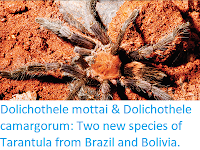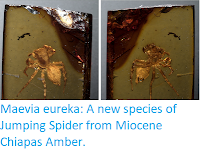The rural municipality of Espírito Santo do Dourado in Minas Gerais State, Brazil, has been troubled by a 'rain' of Spiders this week; a phenomenon in which thousands of Spiders build webs strung from tree-to-tree (or where the opportunity arises, from tree-to-telegraph-pole-to-house-to-tree), high above the town, with the sky appearing filled with Spiders, a harmless, if somewhat alarming sight. This phenomenon is apparently not unusual in this time of year, when the warm, humid climate provides ample insect food for social Spiders of the species Parawixia bistriata.
'Rain' of Spiders over Espírito Santo do Dourado in Minas Gerais State, Brazil, this week. João Pedro Fonseca Martinelli/Terra do Mandu.
Social Spiders are unusual in that the females form colonies of hundreds
to thousands of individuals, which cooperate in the building of webs,
capture of prey, defence of the colony and raising of young. Unlike in
Insects, where social numerous highly successful species are known in
several groups, most of which are exclusively social, of the
approximately 41 000 known species of Spider only about 25 are social.
However sociality appears to have arisen separately at least 18 times in
tropical and subtropical Spiders, suggesting that under some
circumstances there must be strong evolutionary pressure for Spiders to
develop sociality.
Of the 28 described species of Parawixia, only Parawixia bistriata is social, with females resting in a communal nest during the hottest part of the day, and building a framework of long web strands between trees and other tall structures, with individual Spiders building their own orb-webs (which are defended assertively against intrusion by other Spiders) on this framework.
Typical behaviours of Parawixia bistriata. (a) The Spiders’ daytime retreat or bivouac (white arrow). (b) Spiders leaving the bivouac en masse after sunset. (c) Two Spiders passing each other, without any aggressive interaction, while depositing silk on the main support lines before initiating web building. (d) A Spider that has just completed her web. (e) A webless spider (top) is being bounced at by a web owner (bottom). (f) A prey item is shared between a web owner, a spider from a neighbouring web, and a webless spider that had been at the edge of the web. Wenseleers et al. (2013).








